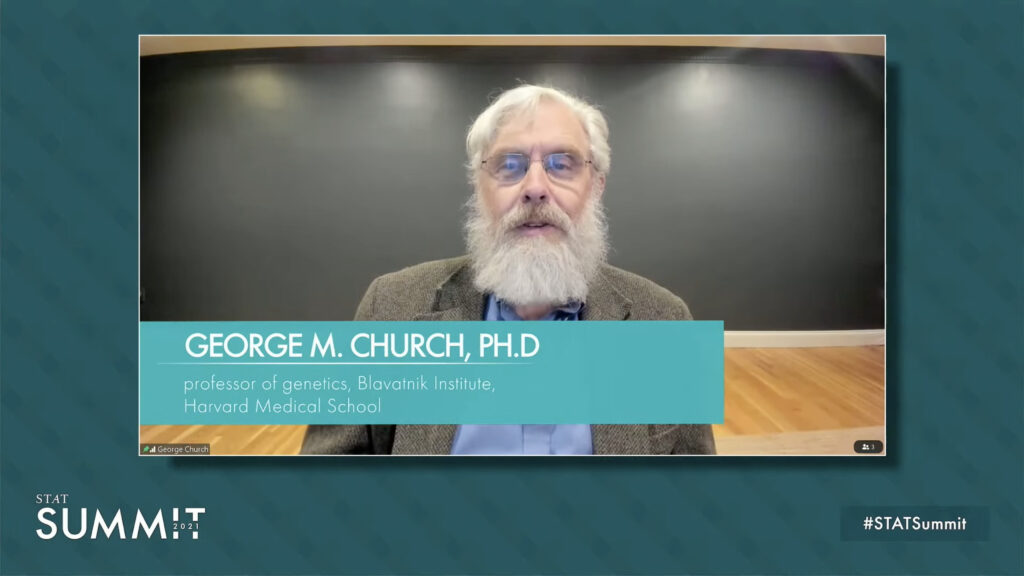George Church, the larger-than-life Harvard biologist who pioneered both DNA sequencing and gene editing, is known for making bold bets. He’s founded more than three dozen companies, including ones promising to curb climate change with cold-tolerant elephants, end inherited disease with a dating app, and keep your DNA out of the hands of hackers through, what else, the blockchain.
What’s behind his audacity? An ‘open mind,’ Church said in a conversation with STAT senior medical writer Matthew Herper during the 2021 STAT Summit. ‘One of the reasons people misestimate is because of exponentials.’
The tendency, he said, is for people to think that exponential technologies — those that double in capacity while halving costs, a la Moore’s Law — are limited to the realm of semiconductors and computing. But that would be a mistake. ‘Now biotech has exponentials that are even faster than electrons and computers and people just constantly neglect that.’
advertisement It was one of many provocative things Church said at the event Wednesday afternoon. Here are a few more:
Enhanced organ engineering
On eGenesis, a company he co-founded to produce human-compatible organs inside the bodies of gene-edited pigs, Church said he expects them to be able to donate not just kidneys, but any organ currently transplanted between humans. ‘And they could actually be better,’ he said. ‘Because a lot of human organs are rejected because of infections or not being healthy enough because of the transport and also pigs are resistant to certain human viruses as well. So there are a lot of opportunities for actually making enhanced organs.’
advertisement Church added that non-human primate studies with donated CRISPR’d pig organs have been going on for more than a year and are going well. As to when the company could apply to the FDA to start trying them in humans? ‘It could be any day.’ How Covid vaccines will bring down the costs of gene therapies
Early on in the pandemic, Church made the decision to take an experimental, DIY vaccine brewed up by one of his former students. He said it was an educational opportunity to demystify the process of vaccine development. He later got the FDA-approved Moderna shots, which he described as another teachable moment, but from the point of gene therapies.
‘Most people don’t think of these as gene therapies, but even the ancient vaccines are in a certain sense introducing genes. In this case, they were literally gene therapies,’ Church said, referring to the vaccines made by Pfizer, Moderna, J&J, and AstraZeneca. ‘They took the common way we thought of gene therapies, which was $2 million a dose down to $4 a dose for the AstraZeneca vaccine, so it really made me feel better about gene therapy knowing there’s a path to a more equitable price.’
When Herper pointed out that calling these mRNA and DNA vaccines ‘gene therapies’ could make some people nervous, Church brushed those concerns aside. ‘By every criteria, they’re gene therapies,’ he said. ‘I don’t see it as my task to reassure people. It’s to try to present things as accurately as I can. And when you’ve got a piece of double-stranded recombinant DNA going into adenoviral capsids, that looks and quacks like a gene therapy.’
The next revolutionary breakthrough?
‘I would probably pick using developmental biology not just for providing organs but for 3D printing in general,’ said Church. Biology, unlike 3D printing, he went on, easily scales up or down — from an ecosystem down to atomic resolution. And it can be harnessed to make things like fiber optic materials and the component parts of semiconductors. ‘There’s no obvious limit, and because proteins and nucleic acids are sensitive down to the sub-nanometer scale, that’s very attractive,’ said Church. When reminded that this choice had echoes of engineering trees to grow chairs, something the founders of Ginkgo Bioworks talked about doing more than a decade ago, Church scoffed.’Growing a chair is easy,’ he said. ‘It’d be a waste of this atomic precision.’
Pigs, mammoths, and whales, oh my!
So what’s next for Church, after he conquers pig-to-human organ transplants and rewilding the Arctic with tree-toppling neo-mammoths? Are there any other animals he hopes to add to his CRISPR menagerie? ‘This is probably enough for me for now,’ he said.
But he did express hopes that other groups who are advancing efforts to use some of the CRISPR techniques developed in the Church lab to bring endangered species back from the brink of extinction will take up the cause of one marine megafauna in particular. ‘I have an affection for the blue whale,’ Church said. ‘I’d love to see that be more common.’
https://www.statnews.com/2021/11/18/growing-a-chair-is-easy-and-other-wisdom-from-george-church/
